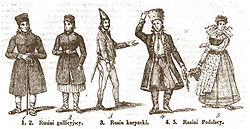Ruthenian people

|
|
| Languages | |
|---|---|
| Previously Ruthenian; currently Belarusian, Ukrainian or Rusyn language |
|
| Religion | |
| Eastern Orthodox, Greek Catholic, Roman Catholic, Protestant | |
| Related ethnic groups | |
| Russians, Ukrainians, Belarusians, Rusyns and other Slavic peoples |
Ruthenians and Ruthenes are archaic English-language exonyms for a Slavic population known in medieval times as the Rus' (or Ruthenia) in various parts of Eastern Europe. Along with Lithuanians, Samogitians and Litvins constituted main population of the Grand Duchy of Lithuania (full name Grand Duchy of Lithuania, Ruthenia and Samogitia).
From the 9th century, the state of ("land of the Rus'"), which was known later as Kievan Rus' was known in Western Europe by a variety of names derived from Rus'. From the 12th century, Rus' was usually known in Western Europe by the Latinised name Ruthenia. In their broadest usage, "Ruthenians" or "Ruthenes" were used to refer to peoples now called Belarusians, Russians, the Rusyn minority and Ukrainians.
By the end of the 18th century, the modern Ukrainian language had been codified. The usual exonyms for Ukraine at the time, like Little Russia (Малороссия, Malorossiya) and Ruthenia, were regarded as unacceptable by Ukrainian nationalists, giving preference to the name "Ukraine", an alternative name used in its literal meaning "Borderlands" at least since the 12th century.
At the same time, however, many Rusyns (Rusyn: Русины, Rusiny; Ukrainian: Русини/Руські, Rusyny/Rus'ki; Belarusian: Русіны; Russian: Русины, Rusiny) did not accept the name Ukrainian or never regarded themselves as such, especially those in Carpathian Ruthenia and the Pannonian Rusyns. Contact with neighbouring languages, such as Slovak, Polish, Hungarian, Romanian and German had created significant linguistic rifts between the Rusyn language and Ukrainian. By the mid-19th century, the Rusyns of Galicia and Lodomeria had codified their language. Many people identifying as Rusyns now regard themselves as a minority. The majority of them live in south-western Ukraine, eastern Slovakia, south-east Poland, north-east Hungary, and north-west Romania. The related Pannonian Rusyns (or Pannonian Ruthenes) live in a transborder region of Serbia and Croatia.
...
Wikipedia
